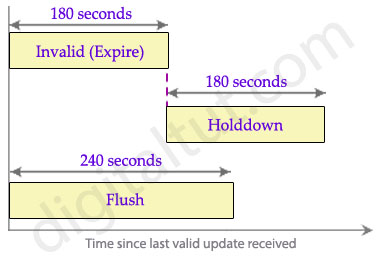RIPng Questions
Question 1
Explanation
The default timers of RIP and RIPng are the same. The meanings of these timers are described below:
Update: how often the router sends update. Default update timer is 30 seconds
Invalid (also called Expire): how much time must expire before a route becomes invalid since seeing a valid update; and place the route into holddown. Default invalid timer is 180 seconds
Holddown: if RIP receives an update with a hop count (metric) higher than the hop count recording in the routing table, RIP does not “believe in” that update. Default holddown timer is 180 seconds
Flush: how much time since the last valid update, until RIP deletes that route in its routing table. Default Flush timer is 240 seconds

Question 2
Question 3
Question 4
Question 5
Question 6
Explanation
This is how to disable split horizon processing for the IPv6 RIP routing process named digitaltut:
Router(config)# ipv6 router rip digitaltut
Router(config-rtr)#no split-horizon
Note: For RIP (IPv4), we have to disable/enable split horizon in interface mode. For example: Router(config-if)# ip split-horizon
Reference: https://www.cisco.com/c/en/us/td/docs/ios-xml/ios/ipv6/command/ipv6-cr-book/ipv6-s6.html
Question 7
Explanation
This is how to change the timers for RIPng:
R1(config)#ipv6 router rip digitaltut
R1(config-rtr)#timers 5 15 10 30 (5: Update period; 15: Route timeout period; 10: Route holddown period; 30: Route garbage collection period)
Note: For IPv4 RIP, we have to change the timers in “(config-router)#”.



Question 5
RIPng Question. Cannot receive RIPng updates. Why?
A. Firewall Port block UDP 520
B. Firewall Port block TCP 520
C. Firewall Port block UDP 521
D. Firewall Port block TCP 521
Correct answer is A.. most of the questions are wrong in this site.
C is correct for RIPng
520 is RIP, 521 is RIPng.
https://en.wikipedia.org/wiki/List_of_TCP_and_UDP_port_numbers
Confirming the 539q dumps are valid.
Passed, if you go the exam study the 539q dumps.
@sang : Is the 539 questions is from the digitaltut you are mentioning ??
Passed, if you go the exam study the 21q dumps.
RIPng is a UDP-based protocol. Each router that uses RIPng has a
routing process that sends and receives datagrams on UDP port number
521, the RIPng port
https://tools.ietf.org/html/rfc2080
So the stated answer is the correct one, C. I guess you have no clue what you’re talking about when you say that “most of the question are wrong”…study my friend.
Passed with the 806q dumps, all questions were from there.
@Keenan can you share the dumps please!
calaca 2 1 2 @ gmail dot com
@all, like say “incorrect it” for Q5
RIP – UDP 520
RIPng – UDP 521
Question 5
RIPng Question. Cannot receive RIPng updates. Why?
A. Firewall Port block UDP 520
B. Firewall Port block TCP 520
C. Firewall Port block UDP 521
D. Firewall Port block TCP 521
Answer : C
A network engineer is enabling RIPng on a new customer link Under which configuration mode is RIPng enabled?
A. Global
B. Router
C. Interface
D. IPv6
Answer: C
shouldn’t it be A, Global ?
Supposedly the question phrasing is giving us more context. The “network engineer is ENABLING RIPng on a new customer link”. So from that we’re supposed to gather that RIPng was already running for older customers and the global configuration for RIPng is in place. So all that would be left would be ENABLING RIPng on the interface for the new customer. So that would make the answer C. Interface, not A….Cisco you soooo crazy.
RIPng uses 521 UDP but rip version 1 & 2 uses 520 UDP port
RIPng uses 521 UDP but rip version 1 & 2 uses 520 UDP port
RIPng sends updates on UDP port 521 using the multicast group ff02::9.
UDP: Typically, RIPng uses UDP as its transport protocol. The well known UDP port for RIPng traffic is 521
@Abdu
Actually you don’t even need to enable RIP in global mode, simply type in ipv6 RIP enable on any interface will create that process ID automatically. Same goes for OSPF and EIGRP